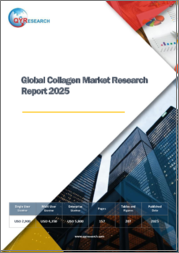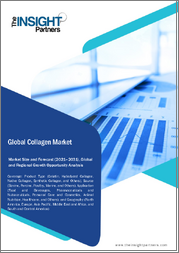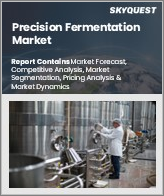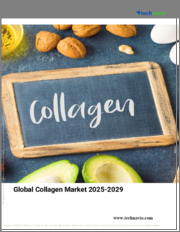
|
시장보고서
상품코드
1541497
콜라겐 시장 보고서 : 공급원, 제품, 용도, 지역별(2024-2032년)Collagen Market Report by Source, Product, Application, and Region 2024-2032 |
||||||
세계 콜라겐 시장 규모는 2023년 100억 달러에 달했습니다. 향후 IMARC Group은 2032년까지 시장 규모가 2024-2032년 사이 5.8%의 연평균 성장률(CAGR)로 169억 달러에 달할 것으로 예상하고 있습니다. 식품 및 음료(F&B) 산업의 제품 사용 증가, 화장품 및 퍼스널케어 제품의 콜라겐 수요 증가, 광범위한 연구 개발(R&D) 활동은 시장을 이끄는 주요 요인 중 일부입니다.
콜라겐은 인체의 다양한 조직과 기관의 구조적 완전성과 강도를 유지하는 데 도움이 되는 필수 단백질을 말합니다. 소, 생선, 돼지, 연어, 대구, 틸라피아, 닭, 가금류, 양에서 상업적으로 생산됩니다. 콜라겐은 식품, 화장품, 상처 치유, 조직 공학, 영양 보충제, 건강보조식품, 섬유 제품, 피부 관리 제품 등에 널리 사용됩니다. 피부 탄력을 촉진하고, 주름을 없애고, 관절의 이동성을 높이고, 뼈를 강화하고, 건강한 소화를 돕습니다. 콜라겐은 또한 건강한 혈류를 유지하고 심혈관 건강을 지원하며 동맥경화와 같은 증상의 위험을 최소화하는 데 도움이 될 수 있습니다.
건강과 웰빙에 대한 소비자의 인식이 높아지는 것은 시장 성장을 촉진하는 요인 중 하나입니다. 콜라겐은 구조적 근육을 지원하고 피부, 뼈, 힘줄, 인대, 연골 및 혈관을 강화하기 위해 널리 소비되고 있습니다. 또한, 스포츠 및 관련 활동에 대한 소비자의 참여 증가로 인해 건강보조식품 및 영양 보조 식품에 대한 제품 사용 증가는 시장 성장에 긍정적인 영향을 미치고 있습니다. 또한 개, 고양이 및 기타 동물의 관절 건강, 이동성 및 전반적인 웰빙을 개선하기 위해 애완동물 관리 산업에서 제품 채택이 증가함에 따라 시장 성장을 지원하고 있습니다. 이와는 별도로, 합성 대안에 비해 더 나은 건강상의 이점을 제공하는 천연 및 지속가능한 성분에 대한 수요가 증가함에 따라 시장 성장에 기여하고 있습니다. 그 외 노인 인구 증가, 온라인 소매점에서의 제품 구매 확대, 생활습관병 유병률 증가, 천연 및 지속가능한 성분에 대한 수요 증가 등이 시장 성장을 촉진할 것으로 예상됩니다.
콜라겐 시장 동향/촉진요인
음료 및 식품 산업에서 제품 활용도 증가
콜라겐은 풍부한 단백질 공급원이기 때문에 단백질 바, 음료, 에너지 레벨을 높이는 분말을 제조하는 데 이상적이며, 식음료(F&B) 산업에서 다양한 용도로 사용되고 있습니다. 또한 요구르트, 아이스크림, 소시지, 크림, 가공육 등의 질감과 입맛을 개선하는 데 널리 사용되면서 시장 성장에 박차를 가하고 있습니다. 이 외에도 드레싱, 소스, 수프, 음료, 마요네즈에서 유화제 및 안정제로서의 제품 사용 증가가 시장 성장에 기여하고 있습니다. 또한, 가볍고 공기처럼 가벼운 식감에 기여하는 기포 특성으로 인해 무스, 디저트 및 휘핑 토핑에 대한 제품 사용이 증가하고 있는 것도 시장 성장에 긍정적인 영향을 미치고 있습니다.
화장품 및 퍼스널케어 제품에서 콜라겐 수요 확대
콜라겐은 크림, 세럼, 마스크와 같은 안티에이징 제품에 널리 사용되며, 보습을 제공하고 피부의 자연적인 콜라겐 생성을 지원하여 젊고 활기찬 외모를 촉진합니다. 또한 다양한 퍼스널케어 제품에서 보습제로 작용하여 피부를 촉촉하고 부드럽고 유연하게 유지시켜 줍니다. 이 외에도 콜라겐은 립 마스크와 립밤과 같은 립 케어 제품에 사용되어 입술의 질감과 상태를 개선하고 건조함을 줄이고 매끄러운 외관을 촉진하는 데 도움을 줍니다. 또한 컨디셔너, 샴푸, 트리트먼트 등 손상된 모발에 영양을 공급하고 회복시켜 윤기를 높이고 더 굵고 건강한 모발을 촉진하기 위해 다양한 헤어케어 제품에 대한 제품 채택이 확대되고 있는 것도 시장 성장에 긍정적인 영향을 미치고 있습니다.
광범위한 연구 개발(R&D) 활동
기존 콜라겐보다 분자량이 작고 생물학적 활성이 강화된 해양 콜라겐 펩타이드의 채택은 시장 성장에 탄력을 받고 있습니다. 또한, 콜라겐 생산을 위한 미생물 발효 기술의 최근 동향은 더 나은 수율을 제공하고 생산 공정의 확장성, 지속가능성 및 효율성을 향상시켜 시장 성장을 지원하고 있습니다. 또한, 캡슐화 기술, 나노 에멀전, 리포좀 전달 시스템 등 콜라겐 및 관련 생리활성 화합물의 안정성, 생체 이용률 및 표적 전달을 향상시키는 첨단 약물전달 시스템의 개발은 시장 성장에 긍정적인 영향을 미치고 있습니다. 이와는 별도로, 고압처리(HPP) 기술을 이용하여 동물성 콜라겐의 구조와 기능성을 유지한 채 추출하는 것이 시장 성장에 긍정적인 영향을 미치고 있습니다.
목차
제1장 서문
제2장 조사 범위와 조사 방법
- 조사 목적
- 이해관계자
- 데이터 소스
- 1차 정보
- 2차 정보
- 시장 추정
- 상향식 접근
- 하향식 접근
- 조사 방법
제3장 주요 요약
제4장 소개
- 개요
- 주요 업계 동향
제5장 세계의 콜라겐 시장
- 시장 개요
- 시장 실적
- COVID-19의 영향
- 시장 예측
제6장 시장 내역 : 공급원별
- 소고기
- 돼지고기
- 가금육
- 해양생물
- 기타
제7장 시장 내역 : 제품별
- 젤라틴
- 가수분해 콜라겐
- 천연 콜라겐
- 합성 콜라겐
- 기타
제8장 시장 내역 : 용도별
- 식품 및 음료
- 시장 동향
- 주요 부문
- 기능성 식품
- 기능성 음료
- 식이보충제
- 제과
- 디저트
- 고기 가공
- 시장 예측
- 의료
- 시장 동향
- 주요 부문
- 뼈와 관절 건강보조제
- 창상 피복재
- 조직 재생
- 의료 임플란트
- 심장병학
- 약물전달
- 시장 예측
- 화장품
- 시장 동향
- 주요 부문
- 미용 보충제(뉴트리코스메틱)
- 외용 화장품
- 시장 예측
- 기타
제9장 시장 내역 : 지역별
- 북미
- 미국
- 캐나다
- 아시아태평양
- 중국
- 일본
- 인도
- 한국
- 호주
- 인도네시아
- 기타
- 유럽
- 독일
- 프랑스
- 영국
- 이탈리아
- 스페인
- 러시아
- 기타
- 라틴아메리카
- 브라질
- 멕시코
- 기타
- 중동 및 아프리카
- 시장 동향
- 시장 내역 : 국가별
- 시장 예측
제10장 SWOT 분석
- 개요
- 강점
- 약점
- 기회
- 위협
제11장 밸류체인 분석
제12장 Porter's Five Forces 분석
- 개요
- 구매자의 교섭력
- 공급 기업의 교섭력
- 경쟁 정도
- 신규 참여업체의 위협
- 대체품의 위협
제13장 가격 분석
제14장 경쟁 상황
- 시장 구조
- 주요 기업
- 주요 기업 개요
- Advanced BioMatrix Inc.
- Collagen Solutions Plc(Rosen's Diversified Inc.)
- Connoils LLC
- Croda International Plc
- Gelita AG
- Gelnex
- ITALGELATINE S.p.A.
- Koninklijke DSM N.V.
- Lapi Gelatine S.p.a.
- Nippi Collagen NA Inc.(Nippi Inc)
- Nitta Gelatin NA Inc.
- Rousselot(Darling Ingredients)
- Tessenderlo Group
The global collagen market size reached US$ 10.0 Billion in 2023. Looking forward, IMARC Group expects the market to reach US$ 16.9 Billion by 2032, exhibiting a growth rate (CAGR) of 5.8% during 2024-2032. The increasing product utilization in the food and beverage (F&B) industry, growing demand for collagen in cosmetics and personal care products, and extensive research and development (R&D) activities are some of the major factors propelling the market.
Collagen refers to an essential protein that aids in maintaining the structural integrity and strength of various tissues and organs in the human body. It is commercially produced from cattle, fish, pigs, salmon, cod, tilapia, chicken, poultry, and sheep. Collagen is widely used in food products, cosmetics, wound healing, tissue engineering, nutraceuticals, health supplements, textiles, and skin care products. It promotes skin elasticity, reduces the appearance of wrinkles, improves joint mobility, strengthens bones, and supports healthy digestion. Collagen also aids in maintaining healthy blood flow, supporting cardiovascular health, and minimizing the risk of conditions such as atherosclerosis.
The increasing awareness among consumers regarding health and wellness is one of the factors catalyzing the market growth. Collagen is widely consumed to provide support to structural muscles and strengthen skin, bones, tendons, ligaments, cartilage, and blood vessels. In addition, the growing product utilization in health supplements and nutraceuticals owing to the increasing consumer participation in sports and allied activities is favoring the market growth. Furthermore, the rising product adoption in the pet care industry to improve the joint health, mobility, and overall well-being of dogs, cats, and other animals is supporting the market growth. Apart from this, the growing demand for natural and sustainable ingredients that offer better health benefits compared to synthetic alternatives is contributing to the market growth. Other factors, including rising geriatric population, widespread product availability across online retail stores, the increasing prevalence of lifestyle diseases, and the growing demand for natural and sustainable ingredients, are anticipated to drive the market growth.
Collagen Market Trends/Drivers:
The increasing product utilization in the food and beverage industry
Collagen finds numerous applications in the food and beverage (F&B) industry, as it is a rich source of protein, making it ideal for producing protein bars, beverages, and powders to boost energy levels. Furthermore, the widespread product utilization to enhance the texture and mouthfeel of yogurts, ice creams, sausages, creams, and processed meat is providing an impetus to the market growth. Apart from this, the increasing product application as an emulsifier and stabilizer in dressings, sauces, soups, beverages, and mayonnaise is contributing to the market growth. Moreover, the growing product utilization in mousses, desserts, and whipped toppings, owing to its foaming properties that contribute to the light and airy texture, is favoring the market growth.
The growing demand for collagen in cosmetics and personal care products
Collagen is widely used in anti-aging products, such as creams, serums, and masks, to promote a youthful and rejuvenated appearance by providing hydration and supporting the skin's natural collagen production. Moreover, it acts as a moisturizer in various personal care products to keep skin hydrated, soft, and supple. Apart from this, collagen is used in lip care products, such as lip masks and lip balms, to improve the texture and condition of the lips, reduce dryness, and promote a smoother appearance. Furthermore, the growing product adoption in various hair care products, such as conditioners, shampoos, and treatments to help nourish and repair damaged hair, enhance shine, and promote thicker and healthier-looking strands, is positively influencing the market growth.
Extensive research and development (R&D) activities
The introduction of marine collagen peptides that possess smaller molecular weight and enhanced bioactivity compared to traditional collagen forms is providing an impetus to the market growth. Furthermore, the recent development of microbial fermentation techniques to produce collagen, which offers better yield and improves the scalability, sustainability, and efficiency of the production process, is supporting the market growth. Additionally, the development of advanced drug delivery systems, such as Encapsulation technologies, nanoemulsions, and liposomal delivery systems, which enhance the stability, bioavailability, and targeted delivery of collagen and its associated bioactive compounds, is positively influencing the market growth. Apart from this, the utilization of the high-pressure processing (HPP) technique to extract collagen from animal sources while preserving its native structure and functionality is favoring the market growth.
Collagen Industry Segmentation:
IMARC Group provides an analysis of the key trends in each segment of the global collagen market report, along with forecasts at the global, regional, and country levels from 2024-2032. Our report has categorized the market based on source, product, and application.
Breakup by Source:
Bovine
Porcine
Poultry
Marine
Others
Bovine dominates the collagen market
The report has provided a detailed breakup and analysis of the collagen market based on the source. This includes bovine, porcine, poultry, marine, and others. According to the report, bovine represented the largest market segment.
Bovine is dominating the collagen market owing to its abundant availability, which ensures a stable and consistent supply for manufacturers. Furthermore, bovine collagen offers a high degree of structural similarity with its human counterpart, thus making it a suitable choice for various applications, including food processing, skincare, and hair care. Apart from this, collagen sourced from bovine is highly cost-effective, which contributes to its large-scale production and applications across various industries. Moreover, the increasing demand for collagen sourced from bovines as it exhibits excellent compatibility with different formulation processes.
Breakup by Product:
Gelatin
Hydrolyzed Collagen
Native Collagen
Synthetic Collagen
Others
Gelatin dominates the collagen market
The report has provided a detailed breakup and analysis of the collagen market based on the product. This includes gelatin, hydrolyzed collagen, native collagen, synthetic collagen, and others. According to the report, gelatin represented the largest market segment.
Gelatin is dominating the collagen market owing to its widespread applications in the food and beverage (F&B) industry as a gelling, stabilizing, and texturizing agent. Moreover, it possesses unique functional properties, such as high water-holding capacity and film-forming properties, which aid in retaining moisture, extending product shelf-life, and enhancing texture. Furthermore, its widespread availability due to the presence of a well-established supply chain and distribution network is acting as another growth-inducing factor. Additionally, gelatin has a long history of consumption and a well-documented safety profile, which further contributes to its market growth.
Breakup by Application:
Food and Beverages
Functional Food
Functional Beverages
Dietary Supplements
Confectionary
Desserts
Meat Processing
Healthcare
Bone and Joint Health Supplements
Wound Dressing
Tissue Regeneration
Medical Implants
Cardiology
Drug Delivery
Cosmetics
Beauty Supplements (Nutricosmetics)
Topical Cosmetic Products
Others
Healthcare dominates the collagen market
The report has provided a detailed breakup and analysis of the collagen market based on the application. This includes food and beverages (functional food, functional beverages, dietary supplements, confectionary, desserts, and meat processing), healthcare (bone and joint health supplements, wound dressing, tissue regeneration, medical implants, cardiology, and drug delivery), cosmetics (beauty supplements (nutricosmetics) and topical cosmetic products) and others. According to the report, healthcare represented the largest market segment.
Collagen finds numerous applications in the healthcare industry owing to its excellent biocompatibility. It is widely used as a biomaterial in medical devices, tissue engineering, and regenerative medicine, as it can be easily processed into scaffolds, films, and matrices to support cell growth, tissue repair, and wound healing. Furthermore, collagen is widely used in orthopedic applications, such as bone graft substitutes, cartilage repair, and joint reconstruction, as it shares similarities with natural tissues. Apart from this, collagen-based materials support tissue regeneration in the oral cavity, which further helps in bone and gum healing. In addition, it acts as a carrier for the controlled release of drugs and bioactive molecules, owing to its biodegradability and biocompatibility.
Breakup by Region:
North America
United States
Canada
Asia-Pacific
China
Japan
India
South Korea
Australia
Indonesia
Others
Europe
Germany
France
United Kingdom
Italy
Spain
Russia
Others
Latin America
Brazil
Mexico
Others
Middle East and Africa
Europe exhibits a clear dominance in the market, accounting for the largest collagen market share
The report has also provided a comprehensive analysis of all the major regional markets, which includes North America (the United States and Canada); Asia Pacific (China, Japan, India, South Korea, Australia, Indonesia, and others); Europe (Germany, France, the United Kingdom, Italy, Spain, Russia, and others); Latin America (Brazil, Mexico, and others); and the Middle East and Africa. According to the report, Europe represented the largest market segment.
Europe is dominating the collagen market due to the presence of a robust network of established collagen manufacturers, suppliers, and research institutions. Furthermore, the implementation of strict regulations by several regional governments to ensure the safety, efficacy, and quality of collagen products is favoring the market growth. Moreover, the growing demand for natural and clean-label products among the regional population due to rising health consciousness among consumers is providing an impetus to the market growth. Furthermore, the widespread adoption of collagen-based products in wound care, tissue engineering, regenerative medicine, and medical devices in the region is contributing to market growth. Additionally, the presence of a well-established trade and export infrastructure, which allows European manufacturers to cater to domestic and global demand, is facilitating the market growth.
Competitive Landscape:
Leading companies in the collagen market are investing in developing new and innovative products to expand their portfolio and cater to increase consumer demands. Furthermore, several key players are engaged in strategic partnerships with distributors, retailers, and industrial stakeholders to tap into new markets and strengthen their existing foothold. Moreover, the increasing marketing and branding efforts by manufacturers through digital marketing channels, social media, influencer partnerships, and collaborations with healthcare professionals to create awareness about the benefits of collagen and educate consumers about their product offerings are supporting the market growth. Additionally, several top companies are leveraging online retail platforms to ensure the availability and visibility of their products across various regions.
The report has provided a comprehensive analysis of the competitive landscape in the global collagen market. Detailed profiles of all major companies have also been provided. Some of the key players in the market include:
Advanced BioMatrix Inc.
Collagen Solutions Plc (Rosen's Diversified Inc.)
Connoils LLC
Croda International Plc
Gelita AG
Gelnex
ITALGELATINE S.p.A.
Koninklijke DSM N.V.
Lapi Gelatine S.p.a.
Nippi Collagen NA Inc. (Nippi Inc)
Nitta Gelatin NA Inc.
Rousselot (Darling Ingredients)
Tessenderlo Group.
Recent Developments:
In April 2023, Gelita AG launched a fast-setting gelatin called CONFIXX that allows for the starch-free production of gummies with a sensory profile that has previously only been attainable with a starch-based manufacturing process. CONFIXX will make the production of gelatin-based gummies possible with virtually any active ingredients, including collagen peptides, melatonin, vitamins, and minerals.
In April 2023, Gelnex was acquired by Darling Ingredients Inc., a leading company that turns food waste into sustainable products. This acquisition was aimed at increasing the Darling's production capacity of collagen to meet rising global demand.
In April 2022, Lapi Gelatine S.p.a announced that it had obtained the Aquaculture Stewardship Council (ASC) certification for its fish gelatin and collagen products.
Key Questions Answered in This Report
- 1. What was the size of the global collagen market in 2023?
- 2. What is the expected growth rate of the global collagen market during 2024-2032?
- 3. What are the key factors driving the global collagen market?
- 4. What has been the impact of COVID-19 on the global collagen market?
- 5. What is the breakup of the global collagen market based on the source?
- 6. What is the breakup of the global collagen market based on the product?
- 7. What is the breakup of the global collagen market based on the application?
- 8. What are the key regions in the global collagen market?
- 9. Who are the key players/companies in the global collagen market?
Table of Contents
1 Preface
2 Scope and Methodology
- 2.1 Objectives of the Study
- 2.2 Stakeholders
- 2.3 Data Sources
- 2.3.1 Primary Sources
- 2.3.2 Secondary Sources
- 2.4 Market Estimation
- 2.4.1 Bottom-Up Approach
- 2.4.2 Top-Down Approach
- 2.5 Forecasting Methodology
3 Executive Summary
4 Introduction
- 4.1 Overview
- 4.2 Key Industry Trends
5 Global Collagen Market
- 5.1 Market Overview
- 5.2 Market Performance
- 5.3 Impact of COVID-19
- 5.4 Market Forecast
6 Market Breakup by Source
- 6.1 Bovine
- 6.1.1 Market Trends
- 6.1.2 Market Forecast
- 6.2 Porcine
- 6.2.1 Market Trends
- 6.2.2 Market Forecast
- 6.3 Poultry
- 6.3.1 Market Trends
- 6.3.2 Market Forecast
- 6.4 Marine
- 6.4.1 Market Trends
- 6.4.2 Market Forecast
- 6.5 Others
- 6.5.1 Market Trends
- 6.5.2 Market Forecast
7 Market Breakup by Product
- 7.1 Gelatin
- 7.1.1 Market Trends
- 7.1.2 Market Forecast
- 7.2 Hydrolyzed Collagen
- 7.2.1 Market Trends
- 7.2.2 Market Forecast
- 7.3 Native Collagen
- 7.3.1 Market Trends
- 7.3.2 Market Forecast
- 7.4 Synthetic Collagen
- 7.4.1 Market Trends
- 7.4.2 Market Forecast
- 7.5 Others
- 7.5.1 Market Trends
- 7.5.2 Market Forecast
8 Market Breakup by Application
- 8.1 Food and Beverages
- 8.1.1 Market Trends
- 8.1.2 Key Segments
- 8.1.2.1 Functional Food
- 8.1.2.2 Functional Beverages
- 8.1.2.3 Dietary Supplements
- 8.1.2.4 Confectionary
- 8.1.2.5 Desserts
- 8.1.2.6 Meat Processing
- 8.1.3 Market Forecast
- 8.2 Healthcare
- 8.2.1 Market Trends
- 8.2.2 Key Segments
- 8.2.2.1 Bone and Joint Health Supplements
- 8.2.2.2 Wound Dressing
- 8.2.2.3 Tissue Regeneration
- 8.2.2.4 Medical Implants
- 8.2.2.5 Cardiology
- 8.2.2.6 Drug Delivery
- 8.2.3 Market Forecast
- 8.3 Cosmetics
- 8.3.1 Market Trends
- 8.3.2 Key Segments
- 8.3.2.1 Beauty Supplements (Nutricosmetics)
- 8.3.2.2 Topical Cosmetic Products
- 8.3.3 Market Forecast
- 8.4 Others
- 8.4.1 Market Trends
- 8.4.2 Market Forecast
9 Market Breakup by Region
- 9.1 North America
- 9.1.1 United States
- 9.1.1.1 Market Trends
- 9.1.1.2 Market Forecast
- 9.1.2 Canada
- 9.1.2.1 Market Trends
- 9.1.2.2 Market Forecast
- 9.1.1 United States
- 9.2 Asia-Pacific
- 9.2.1 China
- 9.2.1.1 Market Trends
- 9.2.1.2 Market Forecast
- 9.2.2 Japan
- 9.2.2.1 Market Trends
- 9.2.2.2 Market Forecast
- 9.2.3 India
- 9.2.3.1 Market Trends
- 9.2.3.2 Market Forecast
- 9.2.4 South Korea
- 9.2.4.1 Market Trends
- 9.2.4.2 Market Forecast
- 9.2.5 Australia
- 9.2.5.1 Market Trends
- 9.2.5.2 Market Forecast
- 9.2.6 Indonesia
- 9.2.6.1 Market Trends
- 9.2.6.2 Market Forecast
- 9.2.7 Others
- 9.2.7.1 Market Trends
- 9.2.7.2 Market Forecast
- 9.2.1 China
- 9.3 Europe
- 9.3.1 Germany
- 9.3.1.1 Market Trends
- 9.3.1.2 Market Forecast
- 9.3.2 France
- 9.3.2.1 Market Trends
- 9.3.2.2 Market Forecast
- 9.3.3 United Kingdom
- 9.3.3.1 Market Trends
- 9.3.3.2 Market Forecast
- 9.3.4 Italy
- 9.3.4.1 Market Trends
- 9.3.4.2 Market Forecast
- 9.3.5 Spain
- 9.3.5.1 Market Trends
- 9.3.5.2 Market Forecast
- 9.3.6 Russia
- 9.3.6.1 Market Trends
- 9.3.6.2 Market Forecast
- 9.3.7 Others
- 9.3.7.1 Market Trends
- 9.3.7.2 Market Forecast
- 9.3.1 Germany
- 9.4 Latin America
- 9.4.1 Brazil
- 9.4.1.1 Market Trends
- 9.4.1.2 Market Forecast
- 9.4.2 Mexico
- 9.4.2.1 Market Trends
- 9.4.2.2 Market Forecast
- 9.4.3 Others
- 9.4.3.1 Market Trends
- 9.4.3.2 Market Forecast
- 9.4.1 Brazil
- 9.5 Middle East and Africa
- 9.5.1 Market Trends
- 9.5.2 Market Breakup by Country
- 9.5.3 Market Forecast
10 SWOT Analysis
- 10.1 Overview
- 10.2 Strengths
- 10.3 Weaknesses
- 10.4 Opportunities
- 10.5 Threats
11 Value Chain Analysis
12 Porters Five Forces Analysis
- 12.1 Overview
- 12.2 Bargaining Power of Buyers
- 12.3 Bargaining Power of Suppliers
- 12.4 Degree of Competition
- 12.5 Threat of New Entrants
- 12.6 Threat of Substitutes
13 Price Analysis
14 Competitive Landscape
- 14.1 Market Structure
- 14.2 Key Players
- 14.3 Profiles of Key Players
- 14.3.1 Advanced BioMatrix Inc.
- 14.3.1.1 Company Overview
- 14.3.1.2 Product Portfolio
- 14.3.2 Collagen Solutions Plc (Rosen's Diversified Inc.)
- 14.3.2.1 Company Overview
- 14.3.2.2 Product Portfolio
- 14.3.3 Connoils LLC
- 14.3.3.1 Company Overview
- 14.3.3.2 Product Portfolio
- 14.3.4 Croda International Plc
- 14.3.4.1 Company Overview
- 14.3.4.2 Product Portfolio
- 14.3.4.3 Financials
- 14.3.4.4 SWOT Analysis
- 14.3.5 Gelita AG
- 14.3.5.1 Company Overview
- 14.3.5.2 Product Portfolio
- 14.3.6 Gelnex
- 14.3.6.1 Company Overview
- 14.3.6.2 Product Portfolio
- 14.3.7 ITALGELATINE S.p.A.
- 14.3.7.1 Company Overview
- 14.3.7.2 Product Portfolio
- 14.3.8 Koninklijke DSM N.V.
- 14.3.8.1 Company Overview
- 14.3.8.2 Product Portfolio
- 14.3.8.3 Financials
- 14.3.8.4 SWOT Analysis
- 14.3.9 Lapi Gelatine S.p.a.
- 14.3.9.1 Company Overview
- 14.3.9.2 Product Portfolio
- 14.3.10 Nippi Collagen NA Inc. (Nippi Inc)
- 14.3.10.1 Company Overview
- 14.3.10.2 Product Portfolio
- 14.3.11 Nitta Gelatin NA Inc.
- 14.3.11.1 Company Overview
- 14.3.11.2 Product Portfolio
- 14.3.12 Rousselot (Darling Ingredients)
- 14.3.12.1 Company Overview
- 14.3.12.2 Product Portfolio
- 14.3.13 Tessenderlo Group
- 14.3.13.1 Company Overview
- 14.3.13.2 Product Portfolio
- 14.3.13.3 Financials
- 14.3.1 Advanced BioMatrix Inc.



















